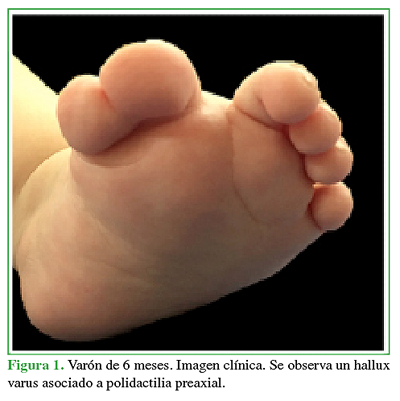Incurvación anterolateral congénita de la tibia asociada con polidactilia. Reporte de un caso y revisión bibliográfica
Contenido principal del artículo
Resumen
Palabras clave: Incurvación tibial; polidactilia; hallux.Nivel de Evidencia: IV
Descargas
Métricas
Detalles del artículo
La aceptación del manuscrito por parte de la revista implica la no presentación simultánea a otras revistas u órganos editoriales. La RAAOT se encuentra bajo la licencia Creative Commons 4.0. Atribución-NoComercial-CompartirIgual (http://creativecommons.org/licenses/by-nc-sa/4.0/deed.es). Se puede compartir, copiar, distribuir, alterar, transformar, generar una obra derivada, ejecutar y comunicar públicamente la obra, siempre que: a) se cite la autoría y la fuente original de su publicación (revista, editorial y URL de la obra); b) no se usen para fines comerciales; c) se mantengan los mismos términos de la licencia.
En caso de que el manuscrito sea aprobado para su próxima publicación, los autores conservan los derechos de autor y cederán a la revista los derechos de la publicación, edición, reproducción, distribución, exhibición y comunicación a nivel nacional e internacional en las diferentes bases de datos, repositorios y portales.
Se deja constancia que el referido artículo es inédito y que no está en espera de impresión en alguna otra publicación nacional o extranjera.
Por la presente, acepta/n las modificaciones que sean necesarias, sugeridas en la revisión por los pares (referato), para adaptar el trabajo al estilo y modalidad de publicación de la Revista.
Citas
etiology, classification, and epidemiologic data. J Pediatr Orthop Br 2000;9(1):11-5.
https://doi.org/10.1097/01202412-200001000-00003
2. Crawford DA, Tompkins BJ, Baird GO, Caskey PM. The long-term function of the knee in patients with fibular
hemimelia and anterior cruciate ligament deficiency. J Bone Joint Surg Br 2012;94(3):328-33.
https://doi.org/10.1302/0301-620X.94B3.27997
3. Shah HH, Doddabasappa SN, Joseph BJ. Congenital posteromedial bowing of the tibia: a retrospective analysis of growth abnormalities in the leg. J Pediatr Orthop Br 2009;18(3):120-8.
https://doi.org/10.1097/BPB.0b013e328329dc86
4. Currarino G, Herring JA, Johnston CE Jr, Birch JG. An unusual form of congenital anterolateral tibial angulationthe delta tibia. Pediatr Radiol 2003;33(5):346-53. https://doi.org/10.1007/s00247-002-0856-7
5. Gilbert A, Brockman R. Congenital pseudarthrosis of the tibia. Long-term follow-up of 29 cases treated by
microvascular bone transfer. Clin Orthop Relat Res 1995;314:37-44. PMID: 7634649
6. Newell RL, Durbin FC. The aetiology of congenital angulation of tubular bones with constriction of the medullary canal, and its relationship to congenital pseudarthrosis. J Bone Joint Surg Br 1976;58:444-7. PMID: 1018030
7. Adamsbaum C, Kalifa G, Seringe R, Bonnet JC. Minor tibial duplication: a new cause of congenital bowing of the
tibia. Pediatr Radiol 1991;21(3):185-8. https://doi.org/10.1007/BF02011043
8. Weaver KM, Henry GW, Reinker KA. Unilateral duplication of the great toe with anterolateral tibial bowing. J
Pediatr Orthop 1996;16:73-7. https://doi.org/10.1097/00004694-199601000-00015
9. Kitoh H, Nogami H, Hattori T. Congenital anterolateral bowing of the tibia with ipsilateral polydactyly of the great toe. Am J Med Genet 1997;73:404-7. PMID: 9415465
10. Bressers MM, Castelein RM. Anterolateral tibial bowing and duplication of the hallux: a rare but distinct entity with good prognosis. J Pediatr Orthop Br 2001;10(2):153-7. PMID: 11360782
11. Manner HM, Radler C, Ganger R, Grossbotzl G, Petje G, Grill F. Pathomorphology and treatment of congenital
anterolateral bowing of the tibia associated with duplication of the hallux. J Bone Joint Surg Br 2005;87:226-30.
https://doi.org/10.1302/0301-620x.87b2.15132
12. Lemire EG. Congenital anterolateral tibial bowing and polydactyly: a case report. J Med Case Rep 2007;1:54.
https://doi.org/10.1186/1752-1947-1-54
13. Breckpot J, Thienpont B, Vanhole C, Van Rossem E, Van Schoubroeck D, Fryns JP, et al. Congenital anterolateral bowing of the tibia with ipsilateral polydactyly of the hallux associated with cerebral cyst: A new entity? Clin Dysmorphol 2009;18:195-200. https://doi.org/10.1097/MCD.0b013e32832d06d7
14. Han J, Qu L, Li Y, Luo J, Cao J, Zhao W. A benign form of congenital anterolateral bowing of the tibia associated
with ipsilateral polydactyly of the hallux: case report and literature review. Am J Med Genet Am 2012;158(7):1742-
9. https://doi.org/10.1002/ajmg.a.35417
15. Beck JJ, Altiok H. Congenital tibial dysplasia with lateral bowing and duplication of hallux: case presentations. J
Pediatr Orthop B 2013;22(3):213-8. https://doi.org/10.1097/BPB.0b013e328352ad09
16. Jahmani R, Alorjani M. Anterolateral bowing of congenital pseudoarthrosis of tibia treated by percutaneous
osteotomy and gradual correction using Taylor spatial frame, then late insertion of a Fussier-Duval nail: a case
report. Am J Case Rep 2018;19:426-30. https://doi.org/10.12659/ajcr.908482

